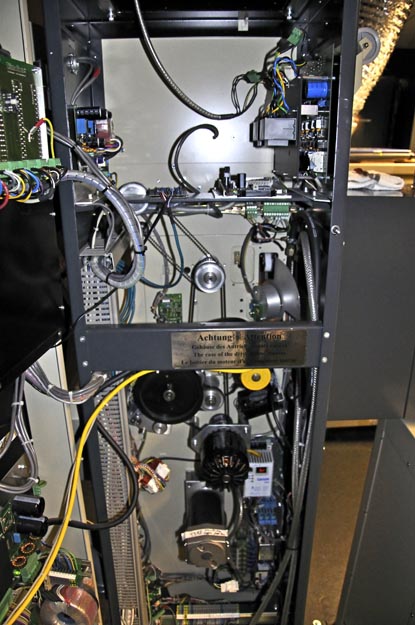
 Home
Home
 Products
Products
 Store
Store
 Forum
Forum
 Warehouse
Warehouse
 Client Login
Client Login
 Contact Us
Contact Us

|
AFI SILVER THEATRE AND CULTURAL CENTER
Inside the projector itself. On the upper-left one can see the LED and preamp supply for the 35mm optical sound. The upper right has the “friction” controller (reel drive). The reel motors are controlled from this board without aid of “dancer arms” or other mechanical connection to the drive sprockets. The main board communicates to the friction board to convey film format, speed and mode. The friction board also gets feed back from the friction motors to ensure smooth and even tension from beginning to the end of the reel. Since these are “studio” grade projectors, they also incorporate the “studio soundheads” with magnetically coupled flywheels. The controller board, located just below the friction board on the cross member of the projector, monitors projector mode, film speed and flywheel speed. If the projector speed is changed from the current speed, the flywheel is decoupled, a motor is pulled in and the flywheel is accelerated/decelerated as necessary and when the speeds match, the flywheel is recoupled. In this manner, the sound drum never slips upon the film and the normal ramp up requirements to get the sound drum up to speed are not needed. For normal projection, the flywheel is spun up to speed the moment the projector is started and waits until the sprockets catch up to couple the flywheel. The sprocket motor is controlled by the inverter (white box in the lower right). In this sense the projector behaves like most others. The shutter is always spinning when the projector is powered on. Its speed is determined by speed of the film. However, since there is no mechanical connection to the sprockets, the projector is free to have the shutter behave like a single, two or three-wing shutter despite it physically being a conventional 2-wing bow-tie type shutter. For speeds below 20fps, it functions as a 3-wing shutter so all presentations are flicker-free and maximize light. It can change modes on the fly too. The yellow object just below the support bracket with the yellow cable is the intermittent motor/encoder. The main board ensures the shutter and intermittent work in harmony. The intermittent can function as a constant feed or intermittent so when the film is shuttled, it is moves through the skate area in a constant flow rather than intermittently. In fact, when the machine starts up, it moves the film constantly until it is up to speed and then switches to intermittent mode. December 2009 photo from the Steve Guttag collection. |
